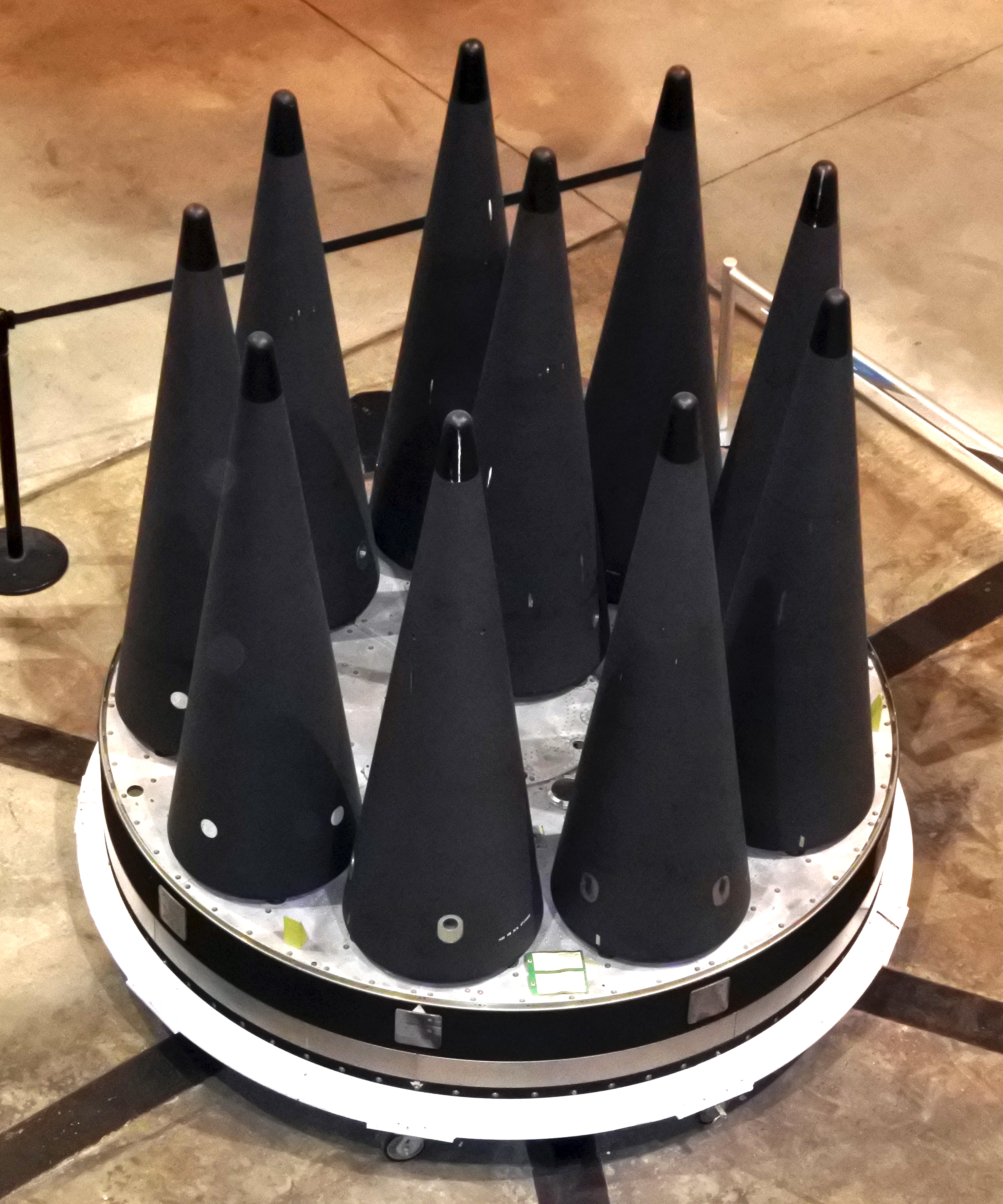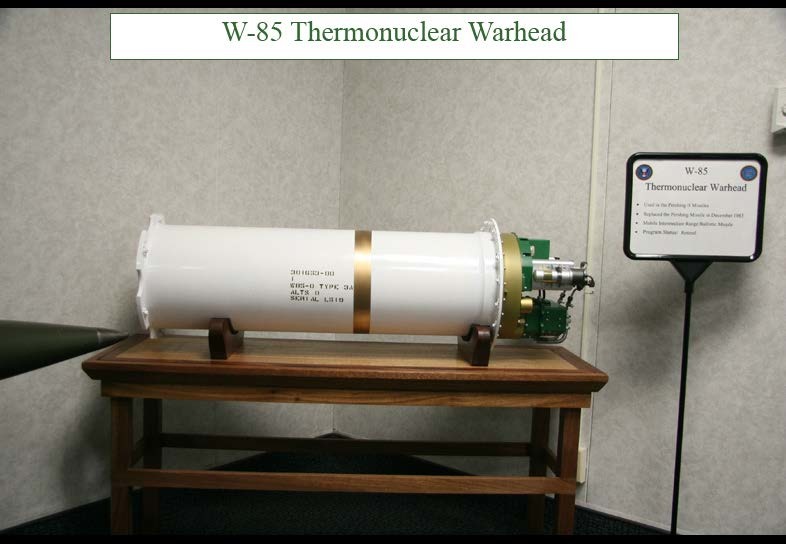|
Maneuverable Reentry Vehicle
The maneuverable reentry vehicle (abbreviated MARV or MaRV) is a type of warhead for ballistic missiles that is capable of maneuvring and changing its trajectory. MaRV can be capable of autonomously tracking ground targets to make sure the missile does not miss the target, because of the frequent trajectory shifts. This often requires some terminal active homing guidance (like Pershing II active radar homing). Advanced Maneuverable Reentry Vehicle The Advanced Maneuverable Reentry Vehicle (AMaRV) was a prototype MARV built by McDonnell Douglas. Four AMaRVs were made and represented a significant leap in reentry vehicle sophistication. Three of the AMaRVs were launched by Minuteman-1 ICBMs on 20 December 1979, 8 October 1980 and 4 October 1981. AMaRV had an entry mass of approximately 470 kg, a nose radius of 2.34 cm, a forward frustum half-angle of 10.4°, an inter-frustum radius of 14.6 cm, aft frustum half angle of 6°, and an axial length of 2.079 meters. ... [...More Info...] [...Related Items...] OR: [Wikipedia] [Google] [Baidu] |
Pershing II MARV
Pershing may refer to: Military * John J. Pershing (1860–1948), U.S. General of the Armies ** MGM-31 Pershing, U.S. ballistic missile system ** Pershing II Weapon System, U.S. ballistic missile ** M26 Pershing, U.S. tank ** Pershing boot, a type of boot used by U.S. soldiers in World War I ** Pershing Rifles, U.S. college military fraternal organization founded 1894 Companies * Pershing, an Italian yachtbuilding company, part of the Ferretti Group as of 2004 * Pershing LLC, a financial brokerage and custodian, and a subsidiary of the Bank of New York Mellon Places ;France * Stade Pershing (Pershing Stadium), a stadium in Vincennes, France ;United States * Pershing, Indiana * Pershing, Oklahoma * Pershing, Wisconsin, a town * Pershing County, Nevada * Pershing Center, an arena in Lincoln, Nebraska * Pershing Park, a small park in Washington, D.C. * Pershing Road (Hudson County), a road along the face of the Hudson Palisades * Pershing Township (other) Other * Andrzej Kol ... [...More Info...] [...Related Items...] OR: [Wikipedia] [Google] [Baidu] |
Agni-P
Agni-P or Agni-Prime ( Agnī ''"Fire"'') is a medium-range ballistic missile being developed by Defence Research and Development Organisation (DRDO) as a successor for Agni-I and Agni-II missiles in the operational service of Strategic Forces Command with significant upgrades in the form of composite motor casing, maneuverable reentry vehicle (MaRV) along with improved propellants, navigation and guidance systems. Agni-P is a two-stage, road mobile and solid-fueled MRBM which is transported by a truck and launched via a canister.It is a ballistic missile with dual redundant navigation and guidance system. It is the sixth missile in the Agni (missile) series of ballistic missile. History and development Beginning in 2016, various media organisations have reported that DRDO is developing a successor of Agni-I called Agni-1P with two stages that borrowed the newer technologies from Agni-IV and Agni-V to increase accuracy and reliability. India started working on area denial we ... [...More Info...] [...Related Items...] OR: [Wikipedia] [Google] [Baidu] |
Re-entry Vehicle
Atmospheric entry is the movement of an object from outer space into and through the gases of an atmosphere of a planet, dwarf planet, or natural satellite. There are two main types of atmospheric entry: ''uncontrolled entry'', such as the entry of astronomical objects, space debris, or bolides; and ''controlled entry'' (or ''reentry'') of a spacecraft capable of being navigated or following a predetermined course. Technologies and procedures allowing the controlled atmospheric ''entry, descent, and landing'' of spacecraft are collectively termed as ''EDL''. Objects entering an atmosphere experience atmospheric drag, which puts mechanical stress on the object, and aerodynamic heating—caused mostly by compression of the air in front of the object, but also by drag. These forces can cause loss of mass (ablation) or even complete disintegration of smaller objects, and objects with lower compressive strength can explode. Crewed space vehicles must be slowed to subsonic speeds be ... [...More Info...] [...Related Items...] OR: [Wikipedia] [Google] [Baidu] |
Multiple Independently Targetable Reentry Vehicle
A multiple independently targetable reentry vehicle (MIRV) is an exoatmospheric ballistic missile payload containing several warheads, each capable of being aimed to hit a different target. The concept is almost invariably associated with intercontinental ballistic missiles carrying thermonuclear warheads, even if not strictly being limited to them. By contrast, a unitary warhead is a single warhead on a single missile. An intermediate case is the multiple reentry vehicle (MRV) missile which carries several warheads which are dispersed but not individually aimed. Only the United States, the United Kingdom, France, Russia, China and India are currently confirmed to have deployed MIRV missile systems. Pakistan is developing MIRV missile systems. Israel is suspected to possess or be in the process of developing MIRVs. The first true MIRV design was the Minuteman III, first successfully tested in 1968 and introduced into actual use in 1970. The Minuteman III held three small ... [...More Info...] [...Related Items...] OR: [Wikipedia] [Google] [Baidu] |
Boost-glide
Non-ballistic atmospheric entry is a class of atmospheric entry trajectories that follow a non-ballistic trajectory by employing aerodynamic lift in the high upper atmosphere. It includes trajectories such as skip and glide. Skip is a flight trajectory where the spacecraft goes in and out the atmosphere. Glide is a flight trajectory where the spacecraft stays in the atmosphere for a sustained flight period of time. In most examples, a skip reentry roughly doubles the range of suborbital spaceplanes and reentry vehicles over the purely ballistic trajectory. In others, a series of ''skips'' allows the range to be further extended. Non-ballistic atmospheric entry was first seriously studied as a way to extend the range of ballistic missiles, but was not used operationally in this form as conventional missiles with extended range were introduced. The underlying aerodynamic concepts have been used to produce maneuverable reentry vehicles (MARV), to increase the accuracy of some mi ... [...More Info...] [...Related Items...] OR: [Wikipedia] [Google] [Baidu] |
Avangard (hypersonic Glide Vehicle)
The Avangard (russian: Авангард; en, Vanguard; previously known as Objekt 4202, Yu-71 and Yu-74) is a Russian hypersonic glide vehicle (HGV) that can be carried as a MIRV payload by the UR-100UTTKh, R-36M2 and RS-28 Sarmat heavy ICBMs. It can deliver both nuclear and conventional payloads. The Avangard is one of the six new Russian strategic weapons unveiled by Russian President Vladimir Putin on 1 March 2018. History According to Vladimir Putin, the US withdrawal from the ABM Treaty in 2002 forced Russia to start developing hypersonic weapons: "We had to create these ypersonicweapons in response to the US deployment of a strategic missile defense system, which in the future would be capable of virtually neutralizing, zeroing out all our nuclear potential". In 2007, when asked about U.S. plans to deploy ballistic missile defenses in Europe, Putin mentioned that Russia was developing “strategic weapons systems of a completely different type that will fly at hyperson ... [...More Info...] [...Related Items...] OR: [Wikipedia] [Google] [Baidu] |
Atmospheric Reentry
Atmospheric entry is the movement of an object from outer space into and through the gases of an atmosphere of a planet, dwarf planet, or natural satellite. There are two main types of atmospheric entry: ''uncontrolled entry'', such as the entry of astronomical objects, space debris, or bolides; and ''controlled entry'' (or ''reentry'') of a spacecraft capable of being navigated or following a predetermined course. Technologies and procedures allowing the controlled atmospheric ''entry, descent, and landing'' of spacecraft are collectively termed as ''EDL''. Objects entering an atmosphere experience atmospheric drag, which puts mechanical stress on the object, and aerodynamic heating—caused mostly by compression of the air in front of the object, but also by drag. These forces can cause loss of mass (ablation) or even complete disintegration of smaller objects, and objects with lower compressive strength can explode. Crewed space vehicles must be slowed to subsonic speeds be ... [...More Info...] [...Related Items...] OR: [Wikipedia] [Google] [Baidu] |
Pershing II
The Pershing II Weapon System was a solid-fuel rocket, solid-fueled multistage rocket, two-stage medium-range ballistic missile designed and built by Martin Marietta to replace the Pershing 1a Field Artillery Missile System as the United States Army's primary nuclear-capable theater-level weapon. The U.S. Army replaced the Pershing 1a with the Pershing II Weapon System in 1983, while the German Air Force retained Pershing 1a until all Pershings were eliminated in 1991. The U.S. Army United States Army Aviation and Missile Command, Missile Command (MICOM) managed the development and improvements, while the Field Artillery Branch (United States), Field Artillery Branch deployed the systems and developed tactical doctrine. Development Development began in 1973 for an updated Pershing. The Pershing 1a had a 400 kt warhead, which was greatly over-powered for the Quick Reaction Alert (QRA) tactical role the weapon system filled. Reducing warhead yield, however, required a signific ... [...More Info...] [...Related Items...] OR: [Wikipedia] [Google] [Baidu] |
R-27 Zyb
The R-27 Zyb was a submarine-launched ballistic missile developed by the Soviet Union and employed by the Soviet Navy from 1968 through 1988. NATO assigned the missile the reporting name SS-N-6 Serb. In the USSR, it was given the GRAU index 4K10. It was a liquid fuel rocket using a hypergolic combination of unsymmetrical dimethylhydrazine (UDMH) as fuel, and nitrogen tetroxide (NTO) as oxidizer. Between 1974 and 1990, 161 missile launches were conducted, with an average success rate of 93%. Total production was 1800 missiles. The R-27 missiles were deployed on the Yankee I submarines, including the K-219. Technical details The missile's body is an all-welded construction made of hard-worked AMg6 (АМг6) aluminium-magnesium-alloy panels, which underwent a two-step process of deep industrial etching and mechanical milling, reducing the plate thickness to one-fifth and one-ninth of the thickness of the original plate. The outer surface of the missile was covered with an ... [...More Info...] [...Related Items...] OR: [Wikipedia] [Google] [Baidu] |
Hyunmoo
Hyunmoo (Korean: 현무; Hanja: 玄武; literally "Black Tortoise" of Asian mythology, which stands for "Guardian of the Northern Sky") is a series of strategic missiles developed by South Korea. The Hyunmoo includes the only ballistic missile reverse engineered by South Korea that was actually deployed. This missile improved the first stage propelling device that was a problem in the previous Baekgom missile. The first test-launch of the Hyunmoo was successful in 1982; the domestic political situation of South Korea delayed the second test-launch until September 1985. The flight test was conducted by the Defense Systems Test Center (DSTC). Hyunmoo-1 Hyunmoo-1 is the first domestically-produced ballistic missile used by the South Korean Army. It was developed by the South Korean national Agency for Defense Development, and is based on the American 1960s Nike Hercules missile system; the US designates it as the Nike Hercules Korea (NHK-1). In 1986, South Korea succeeded in tes ... [...More Info...] [...Related Items...] OR: [Wikipedia] [Google] [Baidu] |
Emad (missile)
Emad ( fa, عماد, lit=pillar) is an Iranian-designed, Liquid-propellant rocket, liquid-fuel, medium-range ballistic missile (MRBM), a derivative of Shahab-3. Description The Emad can carry a 750 kg payload at a range of 1700 km with 10 m accuracy. It uses a new nose cone design, which is different from that of the original Shahab-3. The changed design may also make it possible for the warhead to detonate high above a target, which makes it more suitable for an air burst chemical, biological or nuclear weapon detonation, as well as for nuclear electromagnetic pulse attack.The missile was presented by brigadier general, Brigadier General Hossein Dehghan on 11 October 2015. Emad features a newly designed reentry vehicle with a more advanced guidance and control system, making it the country's first IRBM that is precision-guided. The missile features a Maneuverable reentry vehicle (MARV). With an advanced guidance and control system in its nose cone, the missile's acc ... [...More Info...] [...Related Items...] OR: [Wikipedia] [Google] [Baidu] |







.jpg)